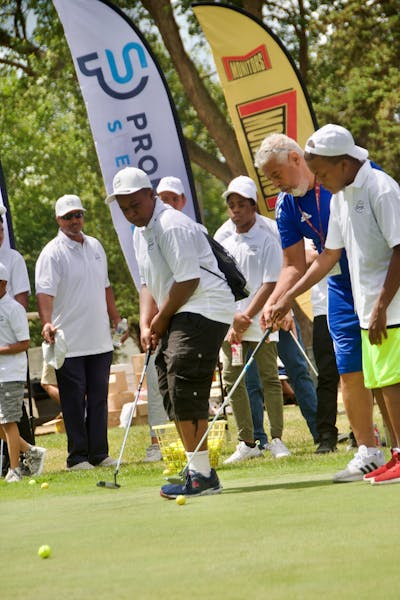A packed Minneapolis Park and Recreation Board hearing on the future of the Hiawatha Golf Course matched impassioned park users who want to restore the waterlogged course's floodplain function against staunch advocates of preserving 18 holes of golf.
Each side cheered loudly for their speakers. The course, historically popular with Black golfers, has been the subject of a yearslong fight as the Park Board tries to figure out its future.
"This fight is ridiculous," Bill English shouted in opposition to proposed flood resiliency plans that would require reducing the course's 18 holes to nine. "If you can put a man on the moon, you can figure out how to protect the water and give us an 18-hole golf course we deserve.
"We will be standing in front of bulldozers, I guarantee you that."
Nicole Cavender urged the Park Board to vote for the $43 million Hiawatha Golf Course Area Master Plan because it offers a compromise between those who want no changes to the course and those who want total ecological restoration without golf.
The plan "provides a reparation for dispossessed land of the Dakota in repairing the damage done to the environment, Mother Earth." she said.
At the same time, Cavender said, Black golfers will get "a redesigned nine-hole course with recognition of the legacy of those golfers that stood up and broke through the barriers that banned them from full participation in the club."
Following the two-hour public hearing, the Park Board's Planning Committee voted to advance the 9-hole plan to the full board in two weeks.
The course is 4 feet below the level of Lake Hiawatha in the Minnehaha Creek floodplain. It has experienced major floods throughout its history and beginning in 2014 was partially closed by floodwaters for more than a year. Park staffers have been trying to redesign the course for better water management ever since.
They created a plan that would reduce the number of holes to nine and create a channel for stormwater to flow more naturally through the course into Lake Hiawatha. Yet despite several attempts and a Park Board turnover, the controversial plan has never gotten enough votes from the divided board to pass.
The Planning Committee approved the plan 3-1, with commissioners Cathy Abene, Elizabeth Shaffer and Tom Olsen in favor and Alicia D. Smith against. Becky Alper was absent.
The committee vote means the course redesign is one step closer to full approval. The plan's fate is not certain, however, as it has neared passage in the past without crossing the finish line.
Earlier this week, the historical consulting firm Hess Roise, commissioned by the golf advocacy organization Bronze Foundation, nominated the Hiawatha Golf Course for listing in the National Register of Historic Places. The filing notes many golf courses in the Twin Cities region played noteworthy roles in racial integration.
The Twin City Golf Club, established by Black golfers in 1931, played at Keller, Gross, Como and Hiawatha courses.
In 1952, the Park Board required the private golf clubs associated with each of its public courses — Columbia, Gross, Meadowbrook, Wirth and Hiawatha — to admit Black golfers. That year, upon the insistence of the St. Paul Jaycees, Black golf legend Solomon Hughes played in a PGA tournament at Keller for the first time after many several years of rejection. According to his family, Hughes integrated the Hiawatha clubhouse that summer. However, the Hiawatha Golf Club would not accept Black members for another 14 years. Celebrity musician Jimmy Bowman was the first.
Still, Hiawatha has maintained a special standing among Black golfers because it is the current host of the annual Upper Midwest Bronze Golf Tournament. Many Black golfers say they feel most welcome there. The originally all-Black tournament launched at Gross Golf Course in 1939 and moved to Wirth from 1940 to 1967. It continued at Hiawatha because by the late 1950s most of the tournament's participants were over age 40 and the hilly Wirth had become too difficult to traverse, according to the Minnesota Spokesman-Recorder.
The Hiawatha historic places nomination does not include the cultural history of the area before wetlands were dredged to create the golf course, which Indigenous park users asked park commissioners to consider two weeks ago.
If the Minnesota State Historic Preservation Review Board recommends the golf course for listing in the National Register, the National Park Service could review it by next spring.
Golf rounds played on all Minneapolis courses declined from 2000 to 2019, according to the Park Board. Over the past five years, rounds played at Hiawatha echoed a nationwide upswing in popularity during the COVID-19 pandemic amid an emphasis on social distancing and reduced opportunities for team and contact sports.
A new water quality memo from Barr Engineering, the firm that the Park Board consulted for the creation of the Hiawatha Golf Course master plan, found that from 2016 to 2021 the board pumped an annual average of more than 420 million gallons of groundwater from the course. That exceeds the latest temporary water appropriation permit of 400 million gallons a year that the Minnesota Department of Natural Resources issued for Hiawatha in expectation that the Park Board would find a permanent solution to its water problems.
Total phosphorus concentrations in the golf course ponds are two to three times that of Lake Hiawatha, which is already considered impaired for excess nutrients by the state Pollution Control Agency, according to the Barr memo. The average phosphorus loads to Lake Hiawatha are estimated to be 368 pounds a year.

The Hamline Elite Meet, already in rare air, presents a co-ed look
Minneapolis to set up Lake Street Community Safety Center, and wants residents' help to define it
Searching for Snoopy: What happened to all the 'Peanuts' statues in St. Paul?
North Oaks withdraws request for density exemption from Met Council

